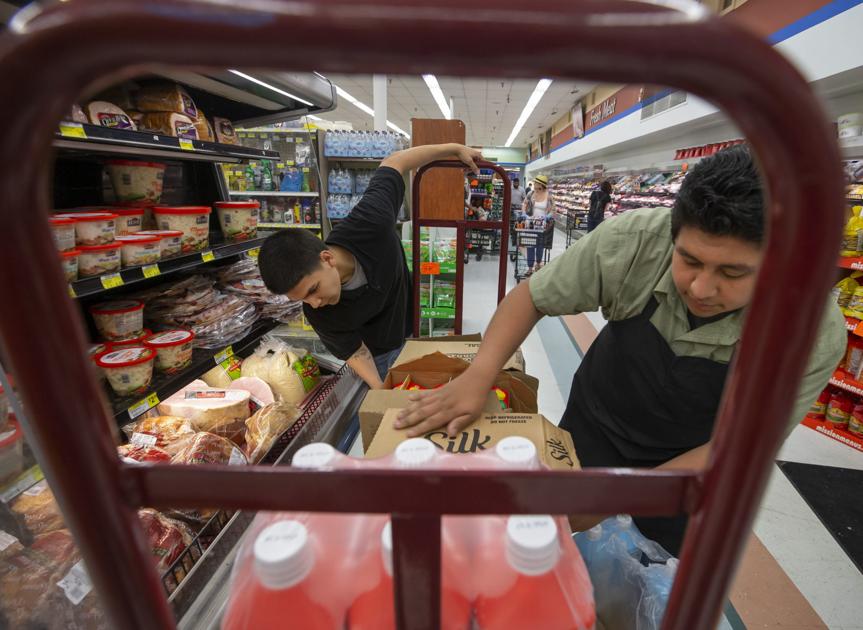LEAGUE CITY
Sean Palmer considers himself to be a rational person, in most instances. Yet, every time he’s walked into a grocery store since the coronavirus pandemic began, he has been gripped by the same instinct to stockpile, he said.
“It’s probably somewhere deep in our collective unconscious, where you see others doing something and we feel the need to do the same,” Palmer, of League City, said.
Palmer’s daughter recently asked him to buy Nutella when he went to the store, which made him wonder whether he might accidentally cause a run on the chocolate and hazelnut spread, he joked.
“I told her that I bet if I ran in there and filled up a shopping cart with it, there’d be five people behind me who would also fill up their shopping carts,” he said.
People across Galveston County have experienced virtually the same thing in grocery stores since the pandemic began — an instinct to stock up on everything. Many have heeded that inner voice, leading to empty shelves, an acute shortage of some necessary items, such as hand soap, and long lines, which in turn feeds the urge to stock up.
But despite crowds and sometimes empty shelves that feed the fear that something, or everything, might run out, in reality the national grocery supply chain is in good shape for the long haul, a leading expert on the topic said.
“In studies of the U.S. grocery industry supply chain, there is between 80 and 120 days of inventory in the chain,” said Ananth Iyer, the department head and senior associate dean of the Krannert School of Management at Purdue University in Indiana.
“It’s a tremendous amount of inventory. But the problem is that the customer doesn’t know that and just sees the particulars of the store. But the system as a whole is efficient. Most manufacturers are still operating, and even more supply is being generated there.”
Nationwide, more than 15,219 people had been diagnosed with the virus as of Friday afternoon, up from 10,442 Thursday, and more than 200 people had died, according to the most recent numbers from the U.S. Centers for Disease Control and Prevention.
Galveston County Health District officials Friday said two more residents had tested positive, bringing the total known cases of coronavirus, or COVID-19, to six.
Widespread concern about those rising numbers and more and more states instituting rules and regulations about movement and restaurants have led to an unprecedented run on different grocery items, including oat milk, meat, hand sanitizer and rubbing alcohol, among others.
“It just takes time to get stuff back in the warehouse, even,” said Ames Arlan, founder and president of the Seabrook-based Arlan’s Market chain of grocery stores, which operate in Galveston and Santa Fe, among other places.
“Our sales are up 200 and 300 percent,” he said. “It’s unexpected. And we’re just working to get caught up.”
The grocery run couldn’t have come at a worse time for Rebecca Bornscheuer, of Kemah, and her husband, Chris.
The couple own a day care center and had just moved its location but couldn’t find food for themselves, let alone the hand sanitizer and other items in bulk necessary for the center, she said. And new rules about how many items someone can purchase have further hampered them.
“We go several times a day or send several people, but sometimes they still don’t have things we need like paper towels, toilet paper and still no cleaning products or hand sanitizer,” she said.
Grocery store supply chains, in most times, are designed to match supply to the rate of demand, which corresponds with consumption, Iyer said.
But for all the jokes about how irrational shoppers are buying up all the toilet paper, they’re actually making a rational decision, in a sense, Iyer argues.
“They’re worried that if it takes two or three weeks for toilet paper to come in, then they need to buy more than they usually would,” he said. “They’re making a completely rational decision based on their read of the situation.”
That decision has caused a sharp rise in demand, but experts suspect it hasn’t meant a corresponding rise in actual consumption of those products, Iyer said. This means there’s light at the end of the tunnel.
“Once people have built up enough safety stock and supply, they’ve purchased what they need, they’re not going to be continually purchasing,” Iyer said.
Grocery stores might run out of some versions of an item, but the supply chain won’t soon have any problems, Iyer said.


